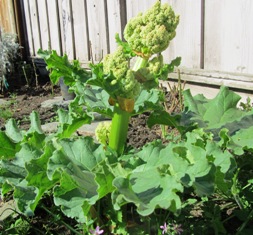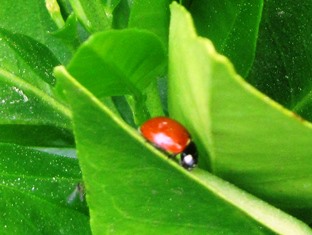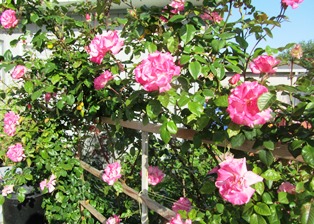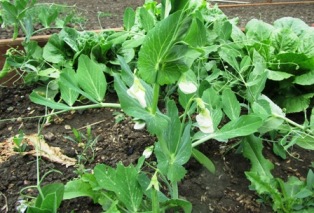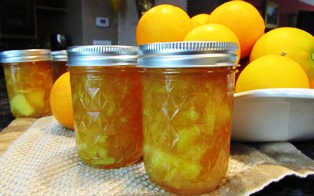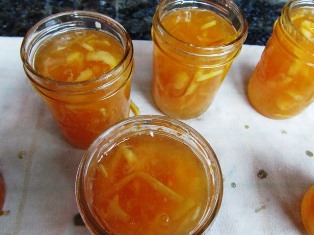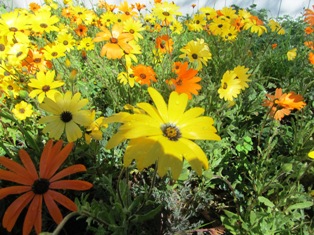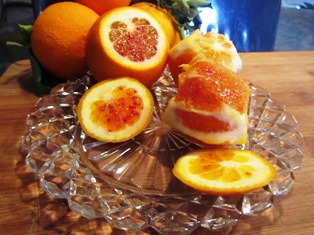Blog Archives
Rhubarb–That “Pie Plant”
In my grandmother’s time, rhubarb’s moniker was the “pie plant” for the simple reason that the tart flavor of its canes nicely tempers the cloying sweetness of other fruits.
Rhubarb, long treated as a fruit, is actually a vegetable. In bygone days when tariffs on imported vegetables were higher than on fruit, a New York court decided in favor of labeling rhubarb as fruit for the purposes of taxation and tariff regulations.
One of the first edibles in the spring garden, rhubarb pushes up leaf stalks or canes (what botanists call petioles) with large leaves. The leaves are are high in oxalic acid and thus poisonous to consume (when harvesting, cut off the tops and discard; snap off the canes for cooking).
Rhubarb stalks or canes, when cooked with sugar or apples (to sweeten), are delicious in pies, jams, sauces and fruit tarts.
Rhubarb is easy to grow (in warm climates, it grows year-round). In cold climates, its leaves and canes will die but the rhizome root will generate new shoots come spring. But if it blooms, cut off the bloom to ensure the root continues to produce canes.
The plant can also be grown in large containers or in greenhouses. It is not fussy about soil, produces new canes year after year, and loves sunlight.
Consumers love those red canes, but rhubarb canes, depending on the variety, aren’t always red–some are light green or pink speckled. The flavor of the light green canes, the type growing on our farmette, has the most robust flavor.
While creating a space for some new plants, we decided to dig out one of our rhubarb plants. That little rhizome I put in the ground four years ago had produced roots 20 inches into the earth. Above ground the plant had grown roughly three feet high and as wide. We will divide it and replant, since it’s a good idea anyway to divide every 3 to 4 years.
We grow Victoria, an old variety with a tendency to flower (or bolt). We prefer to remove those flower spikes in order to keep the plant producing new canes and leaves. Blooms tend to waste the plants resources, see http://www.gardeningknowhow.com/edible/vegetables/rhubarb/rhubarb-bolting.htm. Also see, http://www.hort.purdue.edu/ext/rhubarbflowers.html
In an upcoming posting, I’ll include some recipes for using rhubarb from your garden. In the meantime, consider the different varieties available and perhaps try planting a new and different cultivar. See, http://www.rhubarbinfo.com/varieties.
Have You Planned Your Garden Yet?
Ladybugs and honeybees occasionally meet on the same leaf when both forage for food. The ladybugs dine on aphids while the honeybees seek the sweet nectar of blossoms; orange, tangerine, and lime trees are favorites.
The bug and bee traffic has been steadily increasing now that showers and warm weather have triggered blossoms opening on the fruit and citrus trees around the farmette.
Spring doesn’t officially begin until March 20, but with the weather forecasters predicting upper 70’s Fahrenheit later this week and nighttime temperatures in the 50’s, it is time to consider options for your garden. Many DIY centers are already offering vegetable seedlings, herbs, and berries for planting. Some have markedly discounted their bare-root fruit trees and roses.
I’ve already planted seeds in flats for germination and scattered flower seed (collected from last summer’s flower garden) around prepared beds. When the outside temperatures start to climb, I’ll be rewarded with blooms from nasturtiums, petunias, zinnias, and sunflowers.
The climbing roses are already past the red-leaf stage and are producing the first flush of blooms for spring. The wisteria vines have plump pods ready to unfurl with gorgeous tracts of purple blossoms. And the first green tips of leaves are beginning to sprout on my apples even as the early peaches and apricots already have fruit forming.
This time of year holds the promise of new beginnings, and you see that in every step you take in a garden. Because I prefer to grow plants from varieties of heirloom, open-pollinated seed, I save it from the best specimens grown in the previous season. Of course, some plants freely re-seed themselves. That’s why I now find lettuce and onions and even sweet peas coming up in expected places on the property.
Have you figured out what veggies, flowers, fruits, and berries you’ll plant and grow in your garden this year? If not, now’s a good time to get started. For ideas, check out, http://www.organicgardening.com/learn-and-grow/plan-beautiful-vegetable-garden.
If you prefer, as I do, the non-GMO and organic seeds, there are many excellent sources for them. For heirloom and rare seed, check out http://www.rareseeds.com/store/vegetables/. Also see, http://www.victoryseeds.com/aboutus.html and http://www.anniesheirloomseeds.com/
Easy Orange Marmalade
Who can resist the flavors of homemade jams? Whether it embellishes an appetizer of grilled fig and melted goat cheese or is spread upon a fat slice of fresh-baked bread, jam has power to elevate any meal to another level.
Using the seedless oranges growing on our farmette trees, I’m making marmalade. Marmalade made with the oranges ripening this time of year make great additions to holiday gift baskets. I like to add jars of honey, fresh tangerines, nuts, summer jams, and homemade treats.
RECIPE FOR ORANGE MARMALADE
Ingredients:
4 large oranges (preferably a seedless variety)
2 medium lemons
1/2 teaspoon butter (to reduce foaming)
1/8 teaspoon baking soda
6 Tablespoons dry classic pectin
5 1/2 cups sugar
Directions for Preparing the Jars and Canner:
Wash pint jars in the dishwasher or wash the jars and screw rings in hot soapy water, rinse, and drain upside down on paper towels.
Remove the wire rack from the canner and set aside; then, fill the canner half full of water and bring to a simmer.
Directions for Making the Fruit Mixture:
Wash the oranges and lemons.
Peel the fruit, using a vegetable peeler or a sharp paring knife. Discard any seeds and the pithiest parts of the inner peeling as the pith tastes bitter.
Cut the peeled skins into narrow strips.
Pour water into a saucepan.
Add baking soda and strips of peel.
Bring to boil and then reduce the heat, simmering for 20 minutes and stirring as needed.
Cut the fruit into thin quarters.
Add the fruit and juice to the saucepan of simmering peelings, cover, and allow everything to simmer for 10 minutes.
Remove 4 cups of the fruit/peeling/juice mixture and pour into a large saucepan (6 or 8 quart) or stock pot.
Stir in the pectin and add the butter and sugar, mixing well.
Bring to a roiling boil, stirring constantly, for a full minute and then remove from heat, skimming off any foam.
How to Can the Marmalade:
Ladle the fruit mixture into the warm, clean jars, leaving between 1/4 and 1/8 inch space from the top.
Wipe the jar rims before placing the jars on the wire rack of the canner.
Lower the wire rack of jars into the simmering water in the canner.
Make sure the jars are covered by 2 inches of water (add boiling water if necessary).
Cover with lid and boil for 15 to 20 minutes.
Turn off flame, remove the jars of marmalade, and set them onto a towel to cool.
Listen for the popping sound that signals the lids have sealed. Check lids for seal once the jars have cooled by pushing against the center of the lid. If it springs, the jar has not sealed and must be refrigerated. The marmalade will still be good to eat.
Oats–Farm Cooking Staple Lowers Cholesterol
Steel-cut (Irish) and stone-ground (Scottish) oatmeal has a place on my pantry shelf alongside a container of quick oats. Steel cut means the groats (oat grains) get cut by a steel blade after they have been hulled. The groats of stone-ground oats are cut even smaller than the steel-cut and ground. See http://wholegrainscouncil.org/whole-grains-101/types-of-oats
In rolled oats, the groats are further flattened into flakes. But whether you eat steel-cut oatmeal that takes up to a half hour or more to cook or rolled oats that cook in minutes, you can take comfort in the fact that you are doing something good for your body.
Studies have shown that oatmeal can lower cholesterol, and lower cholesterol reduces the risk of heart disease. Steel-cut oats taste about the same as quick oats and nutritionally, the two two are also similar. See http://www.mayoclinic.com/health/cholesterol/CL00002e
Growing up n a farm, oatmeal made its way to our table on a regular basis. The women in our family also used oatmeal to create sweet treats–cookies and old fashioned deserts. Their crumbles, crisps, and betties incorporated oats in a pastry type topping laid over fruit and baked.
A crumble topping that adds oatmeal and nuts to the flour is known interchangeably as crumble or crisp. Betty is the name applied if the fruit used is an apple variety prepared with sugar, spices, and bread crumbs. The term dates to Colonial America. Sugar sweetens the crumble and butter makes it hang together in a pastry with a crumbly texture.
Here’s an example of how oatmeal might be used in a fruit crumble, crisp, or betty recipe. After sprinkling the topping onto the fruit, the dessert is baked at 375 degrees Fahrenheit for 30-35 minutes.
Ingredients for fruit filling:
6 cups cherries, apples, pears, mixed berries, or other fruit
1 cup sugar (or more, if the fruit is very tart)
1 teaspoon lemon juice (keeps the fruit from turning brown)
1 teaspoon cornstarch (use more if the fruit is very juicy and requires a thickening agent)
1 teaspoon spice such as nutmeg, ginger, or cinnamon, depending on the fruit used
Directions:
Mix fruit and ingredients together and pour into a baking dish.
Ingredients for the crumble/crisp topping:
1 cup flour
1/2 cup oats (optional)
1/2 cup chopped nuts (optional)
1/2 cup brown sugar
1/2 teaspoon baking powder
1/4 teaspoon salt
1/4 teaspoon spice (like cinnamon or ginger, depending on the type of fruit used)
1/2 cup butter (8 Tablespoons)
Directions:
Mix together the dry ingredients and cut in the butter until crumbly. Sprinkle on top of the fruit and bake for 30-35 minutes.
February Color on the Farmette
It’s difficult to find color in the dead of winter. It’s the last week of February and around the farmette it’s beginning to look like spring. Mixed in with the drab brown and gray and green are dazzling splashes of orange and yellow.
On Sunday, my husband and I helped out a neighbor with the pruning of her fruit and citrus trees. My husband will also be removing her aged trellis, cutting back the Japanese wisteria and reducing the size of what looks to be a 20-year-old grape vine.
She had two orange trees both loaded with oranges, so there was harvesting to be done before we could even start pruning back the tree. One was a Valencia orange, known as the juice orange. I cut into several of them this morning and found them streaked with red. What came to mind was that perhaps the busy little honeybees had cross pollinated her Valencia with a Blood Orange. I’m growing several on the farmette.
Citrus trees need little pruning. It’s easy to thin the shoots and branches, rather than shortening the tree. You can also revitalize an old tree that is unproductive (my neighbor’s tree was old but still producing a lot of fruit) by pruning a little more severely but such a severe pruning can stop fruiting for one to two years.
Growers say to feed citrus four times a year; I feed mine once a month with a deep watering. Soils that don’t have good organic matter and nitrogen will benefit from compost, blood meal, cottonseed meal, and well rotted manure on the soil surface out to the drip line. If your citrus isn’t performing for you, try scratching around the surface of the soil under the tree. This stresses the surface roots. Citrus need good drainage. Water slowly and deeply.
We’ve been lucky to have a stretch of warm, sunny days here in Northern California at the end of February. The fruit and nut trees have burst into bloom. Around the farmette, there are pink and white buds opening on the apple, apricot, peach, and almond trees.
The field in the back is knee-high with wild mustard and its blooms are bright yellow on green stalks. The yellow and orange daffodils and purple hyacinths create a floral motif on the drab winter cloak of Mother Nature . . . at least here on the Henny Penny Farmette. Just another reason why I love living here.
 Facebook
Facebook Goodreads
Goodreads LinkedIn
LinkedIn Meera Lester
Meera Lester Twitter
Twitter






